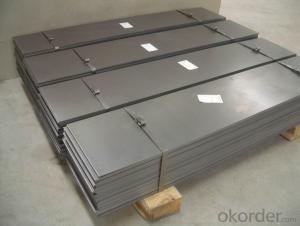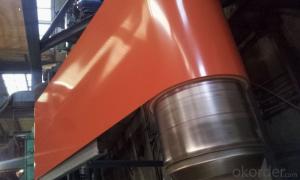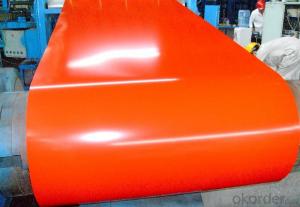Galvanized Steel Sheet in Ciols with Prime Quality Best Seller
- Loading Port:
- Shanghai
- Payment Terms:
- TT OR LC
- Min Order Qty:
- 100 m.t.
- Supply Capability:
- 10000 m.t./month
OKorder Service Pledge
OKorder Financial Service
You Might Also Like
1.Structure of Galvanized Steel Coil Description:
Hot-dip galvanized steel coils are available with a pure zinc coating through the hot-dip galvanizing process. It offers the economy, strength and formability of steel combined with the corrosion resistance of zinc. The hot-dip process is the process by which steel gets coated in layers of zinc to protect against rust. It is especially useful for countless outdoor and industrial applications.
2.Main Features of the Galvanized Steel Coil:
• Base material for countless outdoor and industrial applications
• High corrosion resistance
• High strength
• Good formability
• Rust- proof ability
• Good visual effect
3.Galvanized Steel Coil Images

4.Galvanized Steel Coil Specification
Operate Standard: ASTM A653M-04/JIS G3302/DIN EN10143/GBT 2518-2008
Grade : SGCD,SGCH, Q195,DX51D
Zinc coating :40-180g( as required)
Width:914-1250mm(914mm, 1215mm,1250mm,1000mm the most common)
Coil id:508mm/610mm
Coil weight: 4-10 MT(as required)
Surface: regular/mini/zero spangle, chromated, skin pass, dry etc.
5.FAQ of Galvanized Steel Coil
We have organized several common questions for our clients,may help you sincerely:
1.How to guarantee the quality of the products?
We have established the international advanced quality management system,every link from raw material to final product we have strict quality test;We resolutely put an end to unqualified products flowing into the market. At the same time, we will provide necessary follow-up service assurance.
2. What is the minimum order quantity ?
Our MOQ is 50mt for each size. And we will consider to give more discount if you make big order like 1000 tons and more. Further more, the more appropriate payment term your offer the better price we can provide.
3.How long can we receive the product after purchase?
Usually within thirty working days after receiving buyer’s advance payment or LC. We will arrange the factory manufacturing as soon as possible. The cargo readiness usually takes 15-25 days, but the shipment will depend on the vessel situation.
- Q:What are the different steel strip rolling processes?
- In the manufacturing industry, there exist numerous steel strip rolling processes that are commonly employed. These procedures serve to shape and reduce the thickness of steel strips according to specific requirements. One frequently utilized method is hot rolling, which entails subjecting the steel to high temperatures and passing it through a series of rollers. This procedure not only reduces the strip's thickness, but also enhances its mechanical properties and surface finish. Hot rolling is often employed in the production of steel strips for structural applications. Another technique is cold rolling, which takes place at room temperature. This process is employed to further reduce the strip's thickness and enhance its dimensional accuracy and surface finish. Cold rolled steel strips find extensive use in industries like automotive and appliance manufacturing, where precision and quality are paramount. A variation of cold rolling is skin pass rolling, which involves a light cold rolling pass to enhance the surface finish and eliminate defects on the steel strip. Skin pass rolling is commonly employed in the production of top-notch steel strips for applications such as electrical transformers and electrical appliances. Moreover, temper rolling is a process utilized to improve the flatness and shape of the steel strip. It involves passing the strip through a series of rolls with controlled tension to alleviate internal stresses and attain the desired flatness. Furthermore, there are specialized rolling processes like annealing and galvanizing. Annealing involves heating the steel strip to a specific temperature and then gradually cooling it to enhance its mechanical properties and reduce internal stresses. Galvanizing is a process wherein a layer of zinc is applied to the steel strip to provide corrosion resistance. Each of these steel strip rolling processes possesses its own unique advantages and finds application in specific domains. The choice of process depends on factors such as the desired properties of the steel strip, the required thickness reduction, and the intended application of the final product.
- Q:How are steel strips used in the manufacturing of mining equipment?
- Steel strips are used in the manufacturing of mining equipment to provide strength, durability, and resistance to heavy loads and harsh conditions. These strips are typically used as structural components, such as frames, supports, and reinforcements, ensuring the equipment can withstand the demanding environments found in mining operations.
- Q:How are steel strips used in the production of metal furniture hardware?
- The versatility and strength of steel strips make them a popular choice for metal furniture hardware production. These strips are created by rolling steel sheets through a series of rollers, resulting in the desired thickness and shape. Once acquired, the steel strips can be further processed to manufacture various components of metal furniture hardware, including brackets, hinges, handles, and drawer slides. Specialized tools and machinery are used to cut, bend, and shape the strips into specific forms. One of the main purposes of incorporating steel strips in metal furniture hardware is to provide reinforcement. By integrating steel strips into the design, the strength and durability of the furniture hardware are significantly improved. This is especially important for components that bear heavy loads or undergo frequent movement, such as hinges and drawer slides. Steel strips also have decorative applications in metal furniture hardware. They can be utilized to add aesthetic details and enhance the overall appearance of the furniture. For example, steel strips can be bent or twisted to create intricate designs or patterns on handles and brackets, imparting a stylish and sophisticated look to the furniture. Moreover, steel strips are commonly employed to offer structural support to the furniture. They can be integrated into the frame or structure of the furniture, ensuring increased stability and preventing sagging or warping over time. Due to their exceptional strength and rigidity, steel strips are ideal for guaranteeing the longevity and functionality of metal furniture. In conclusion, steel strips are vital in the production of metal furniture hardware, serving purposes such as reinforcement, decoration, and structural support. They provide strength, durability, and aesthetic appeal to the final product.
- Q:What are the different methods for bending steel strips?
- There are several methods for bending steel strips, each with its own advantages and applications. Some of the most common methods include: 1. Press brake bending: This method involves using a press brake machine, which applies force to bend the steel strip into the desired shape. The strip is placed between a punch and a die, and the machine applies pressure to create the bend. Press brake bending is commonly used for precision bending and creating complex shapes. 2. Roll bending: In this method, the steel strip is passed through a series of rollers that gradually apply pressure to bend the strip. This technique is typically used for large-scale, continuous bending operations and is suitable for creating long, curved shapes. 3. Induction bending: This method involves using an induction heating system to heat the steel strip to a malleable temperature. Once heated, the strip is bent using a bending machine or a specially designed mandrel. Induction bending allows for precise control over the bending process and is commonly used for creating smooth and consistent bends in large steel strips. 4. Rotary-draw bending: This method utilizes a bending machine equipped with a rotating die, which grips the steel strip and pulls it around a bend form. Rotary-draw bending is often used for producing tight, precise bends in small to medium-sized steel strips. 5. Mandrel bending: Mandrel bending involves inserting a mandrel, typically a solid rod or flexible coil, into the steel strip before bending. The mandrel provides support to the inner surface of the strip, preventing it from collapsing or deforming during the bending process. This method allows for the creation of smooth, wrinkle-free bends and is commonly used in applications where a high-quality finish is required. 6. Hammer bending: This traditional method involves using a hammer or mallet to manually shape the steel strip by striking it against a form or mold. Although it is a labor-intensive process, hammer bending is often used for small-scale or custom bending applications. Each method has its own advantages and limitations, and the choice of bending method will depend on factors such as the desired shape, material properties, production volume, and budget.
- Q:What is the impact strength of a steel strip?
- The impact strength of a steel strip refers to its ability to withstand sudden, forceful impacts without fracturing or breaking. It is a measure of the strip's resistance to impact or shock loading.
- Q:How are steel strips used in the production of industrial valves?
- Industrial valves require steel strips as essential components during their manufacturing process. These strips serve multiple purposes throughout production. To begin, steel strips are commonly utilized in forming the valve body. Specifically cut and shaped into specific sizes and dimensions, these strips create the outer casing. They are often rolled and welded together, ensuring a robust and seamless structure capable of withstanding high pressure and temperature conditions. Additionally, steel strips are instrumental in fabricating the valve's internal components, including the stem, disc, and seat. These components play a crucial role in regulating fluid or gas flow. Precisely cut and machined, the strips form these parts, which are then assembled into the valve. Furthermore, steel strips find application in producing valve accessories, such as bonnets, flanges, and packing glands. These accessories provide additional support and functionality, guaranteeing the valve's proper operation. Shaping and forming the steel strips allows for the creation of these accessories, which are subsequently attached to the valve body. Moreover, steel strips are often involved in the coating process of industrial valves. They can be coated with various materials like epoxy, rubber, or Teflon to enhance corrosion resistance, durability, or sealing properties. These coatings are applied to the steel strips before they are formed into the valve components. In summary, steel strips hold great significance in the manufacturing of industrial valves. They contribute to forming the valve body, fabricating internal components, creating valve accessories, and providing coatings. By utilizing steel strips, manufacturers can produce high-quality valves that meet the demanding requirements of diverse industries.
- Q:How are steel strips used in the production of pipes?
- Steel strips are an integral part of the production process for pipes. These strips, which are usually made from high-quality steel, serve as the raw material for manufacturing pipes. They are utilized in various stages of the pipe production process. Firstly, steel strips are often used in the initial step of pipe production, which is known as the forming stage. During this phase, the steel strips are shaped into the desired pipe shape by passing them through a series of rollers or forming machines. The strips are bent, curved, or welded together to create the required pipe dimensions and shape. After the forming stage, the steel strips are further processed in the welding stage. Here, the strips are joined together through a welding process, usually using high-frequency induction welding or electric resistance welding. This welding process ensures that the steel strips become firmly connected, resulting in a seamless and durable pipe. Once the welding is complete, the formed and welded steel strips undergo a series of finishing processes. These processes include heat treatment, surface cleaning, and coating to enhance the corrosion resistance and overall quality of the pipes. The steel strips are often subjected to heat treatment to improve the mechanical properties and remove any residual stresses. Finally, the finished steel strips are cut into the desired length and shaped into the final pipe product. These pipes can be used in various applications, such as plumbing, construction, oil and gas transportation, and infrastructure projects. In summary, steel strips play a crucial role in the production of pipes. They are used in the forming, welding, and finishing stages of pipe manufacturing, resulting in high-quality, durable, and versatile pipes that can be utilized in numerous industries and applications.
- Q:What are the factors that affect the impact resistance of steel strips?
- The impact resistance of steel strips can be significantly influenced by various factors. These factors include the chemical composition of the steel strip, its hardness, microstructure, heat treatment, surface condition, thickness, temperature, and manufacturing process. 1. In terms of composition, the impact resistance of a steel strip is greatly affected by its chemical makeup. The presence of certain alloying elements, such as manganese, nickel, and chromium, can enhance its ability to withstand impact forces. 2. The hardness of the steel strip is another crucial factor. Steel strips that have been hardened generally exhibit higher impact resistance because they have the capability to absorb energy and resist deformation under impact. 3. The microstructure of the steel strip, including factors like grain size and distribution, also plays a significant role. A fine and uniform microstructure tends to enhance its toughness and resistance to crack propagation. 4. Heat treatment processes, like quenching and tempering, can have a significant impact on the steel strip's resistance to impact. Proper heat treatment can improve its strength and toughness, making it more resistant to impact. 5. The surface condition of the steel strip, including factors like surface roughness and defects, can also affect its impact resistance. Smooth and defect-free surfaces generally provide better resistance against impact forces. 6. The thickness of the steel strip is another factor to consider. Thicker strips generally offer better resistance to impact as they are able to absorb and distribute energy more effectively. 7. The temperature at which the steel strip operates can also affect its impact resistance. Steel strips exposed to low temperatures may become more brittle, reducing their ability to withstand impact forces. 8. The method used to manufacture the steel strip can also influence its impact resistance. Factors such as rolling, heat treatment, and cooling methods can all have an impact on the final properties of the strip, including its resistance to impact. Overall, a combination of these factors determines the impact resistance of steel strips. Manufacturers must carefully consider these factors to ensure that the steel strips meet the specific impact resistance requirements for their intended applications.
- Q:How are steel strips used in packaging industry?
- The packaging industry commonly utilizes steel strips for various purposes. One of their main uses is as strapping material to secure and reinforce packages. These strips possess strength and durability, making them an ideal choice for holding together heavy or bulky items during transportation. To create tight and secure packaging, steel strips are frequently employed alongside strapping tools and equipment. They can be wrapped around packages and tightened using tensioning tools, ensuring that the contents remain stable and well-protected. This helps minimize the risk of damage or shifting of goods during transit, reducing the chances of breakage or loss. Apart from their strength, steel strips also exhibit excellent resistance to moisture, temperature, and impact. This attribute renders them suitable for packaging goods that require additional protection, such as construction materials, machinery parts, or large appliances. Steel strips provide an additional layer of security and stability, guaranteeing that the packaged items reach their destination intact. Furthermore, steel strips offer high versatility and can be tailored to meet specific packaging requirements. They can be cut into various lengths and widths, allowing for flexibility in securing packages of different sizes and shapes. Steel strips can also be coated or treated to enhance their resistance to corrosion, thereby prolonging their lifespan. Overall, steel strips play a crucial role in the packaging industry by providing a dependable and robust solution for securing and safeguarding goods during transit. Their strength, durability, and customization options make them an indispensable component in ensuring safe and secure packaging for a wide range of products.
- Q:Are steel strips used in the production of HVAC systems?
- Steel strips are commonly employed in the production of HVAC systems, including heating, ventilation, and air conditioning. These versatile and durable materials are utilized for various components like air ducts, pipes, and support structures. Typically, these steel strips are crafted from galvanized steel, which is coated with a layer of zinc to enhance resistance against corrosion. By utilizing steel strips, the HVAC system is guaranteed to possess strength, durability, and the ability to endure the demands of heating, cooling, and ventilation in diverse environments.
1. Manufacturer Overview |
|
|---|---|
| Location | |
| Year Established | |
| Annual Output Value | |
| Main Markets | |
| Company Certifications | |
2. Manufacturer Certificates |
|
|---|---|
| a) Certification Name | |
| Range | |
| Reference | |
| Validity Period | |
3. Manufacturer Capability |
|
|---|---|
| a)Trade Capacity | |
| Nearest Port | |
| Export Percentage | |
| No.of Employees in Trade Department | |
| Language Spoken: | |
| b)Factory Information | |
| Factory Size: | |
| No. of Production Lines | |
| Contract Manufacturing | |
| Product Price Range | |
Send your message to us
Galvanized Steel Sheet in Ciols with Prime Quality Best Seller
- Loading Port:
- Shanghai
- Payment Terms:
- TT OR LC
- Min Order Qty:
- 100 m.t.
- Supply Capability:
- 10000 m.t./month
OKorder Service Pledge
OKorder Financial Service
Similar products
New products
Hot products
Related keywords




























